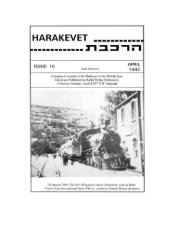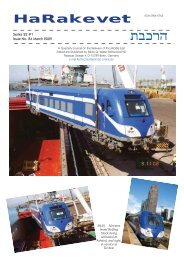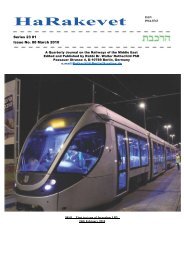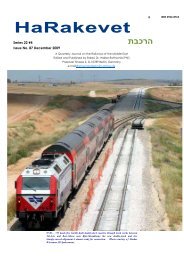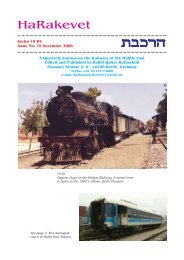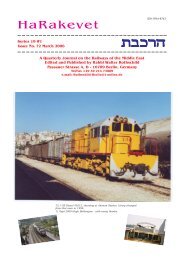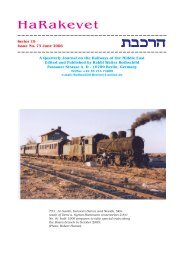You also want an ePaper? Increase the reach of your titles
YUMPU automatically turns print PDFs into web optimized ePapers that Google loves.
1935-37 period and equipped with powerful<br />
diesel engines at each end. They seat<br />
twenty-eight passengers and contain, a bit<br />
abaft of amidships, a bar dispensing warm<br />
beer and sticky soft drinks. This amenity is not<br />
to be regarded lightly in the Red Sea heat.<br />
These cars make the run in three hours and<br />
forty-five minutes and they are usually on<br />
time. From the front seat you can get an unimpeded<br />
engineer’s view of the line.<br />
The rail car departs from a halt just<br />
outside the port gates on the Island of Massaua.<br />
It crosses the causeway leading to the<br />
Island of Tallud and stops again at the main<br />
station. The next stop is a few hundred yards<br />
further on for passengers who have walked<br />
over from the CIAAO Hotel. The final Massaua<br />
stop is on the mainland side of the causeway<br />
leading from the Island of Tallud. While crossing<br />
this causeway you can look back and see<br />
the white buildings silhouetted against the<br />
blue sky. At this distance Massaua looks clean<br />
and inviting.<br />
At this halt three Eritrean policemen<br />
in British-style battledress board the car.<br />
They poke their Lee-Enfield .303 rifles out of<br />
an open window and slam home a full clip.<br />
If you are not the nervous type the click of<br />
the bolt as a live cartridge is pushed home<br />
into the chamber adds spice to the trip. The<br />
precautions are taken against the shifta - the<br />
Amharic word for bandit.<br />
The Shifta started as local patriots<br />
against the Italian occupation, and as such,<br />
their activities were encouraged. When the<br />
Italians had been driven out they continued<br />
against the British Administration, for by this<br />
time they had become thoroughly to enjoy<br />
their lives of crime. They are still in business<br />
today and their only concession to independence<br />
is to stop killing the people they<br />
rob. They are principally active on the highway<br />
and usually take all their victim’s clothes,<br />
leaving him to drive into town in his birthday<br />
suit. They have been known to hold up trains,<br />
which gives this trip a somewhat Wild West<br />
flavor.<br />
The first section is 18.2 miles from<br />
Massaua to Mai Atal, across a typical coastal<br />
desert where the only vegetation is the<br />
thorn-bush. Some of these East African deserts<br />
are horrible in their desolation, especially<br />
in those regions where one finds the charred<br />
lava beds, sulphur yellow and and blood red<br />
sandstone. But this strech is often pretty, and<br />
after an occasional rain can be quite beautiful,<br />
with the thorn-bushes decked out in<br />
green and yellow.<br />
The rail car runs at a steady twenty-five<br />
miles per hour and the wind whips<br />
across one’s face like an oxy-acetylene flame,<br />
and even the warm beer served aboard furnishes<br />
temporary relief for parched throats<br />
and lips. Six miles out of Massaua you start<br />
up a 1.7 per cent grade and by the time you<br />
have crossed the dry river bed at Dogali on<br />
a thirteen arch brick and masonry bridge the<br />
grade has steepened to 2.8 per cent. At Mai<br />
Atal, where the aerial ropeway crosses the<br />
railroad, you are 551 feet above sea level.<br />
Shortly after leaving Mai Atal, the<br />
highway and the railroad part company, and<br />
the railroad enters a broad valley alongside<br />
the dry bed of a river, or what is locally called<br />
a torrent. Such channels are dry most of the<br />
year, except when it rains on the plateau,<br />
when a wall of water rushes down the precipitious<br />
grade and flings itself into the sea. In<br />
a few days it has dried up and gone.<br />
In this valley one gets a feeling of<br />
extreme remoteness. Herds of camels nibble<br />
at the leaves of the thorn-bushes and somehow<br />
escape impaling their lips on the thorns.<br />
As they move they raise a cloud of dust that<br />
remains suspended in the still air. The flat floor<br />
of the valley contains native farms where<br />
corn struggles against the drought. In the<br />
distance the mountains are obscured with a<br />
blue heat haze which gives a sense of unreality<br />
and blurs the horizon. This is harsh and<br />
brutal country and inspires either to hatred or<br />
wonder.<br />
You are returned to reality as the<br />
operator pneumatically shifts gears and the<br />
twin diesel engines growl as the car squeals<br />
around the 128 foot radius curves on the 3<br />
per cent grade.<br />
A short distance from Damas you<br />
encounter the first and second of the thirty<br />
tunnels on the line as the rain winds in and<br />
out of the lava rock formations that make up<br />
the slope which you are climbing. You realize<br />
that the twenty-five years for the construction<br />
passed quickly when you see the<br />
tunnels and deep cuts which were hacked<br />
out of the rock by muscle, sledge hammer,<br />
drill steel and black powder. There is a short<br />
stretch of downgrade into Damas station and<br />
then the climb is resumed at 2.6 percent.<br />
The valley as you approach Ghinda<br />
narrows until it is less than a hundred yards<br />
wide. After three tunnels in quick succession<br />
you cross and recross the Dongollo Torrent<br />
on six closely-spaced bridges. Suddenly,<br />
as the valley reaches its narrowest point, it<br />
bursts out into a small plain and you roll into<br />
Ghinda station 43.15 miles from the coast<br />
and 3,258 feet above sea level.<br />
The transformation is dramatic because<br />
of its suddenness. All at once life becomes<br />
bearable for the altitude has robbed<br />
the sun of its sting. The vegetation undergoes<br />
a complete change, for the thorn-bush is<br />
gone and is replaced by bushes which might<br />
be found anywhere in the temperate zone.<br />
Even in the dry season the Ghinda plain is<br />
green.<br />
At the station the three policemen<br />
get off and return to the coast on the rail car<br />
which is waiting on the siding. The operator<br />
takes a few minutes to get a new set of train<br />
orders and to gossip with the loafers assembled<br />
on the platform. It is evident that the arrival<br />
and departure of the littorina is watched<br />
with special interest for these cars carry only<br />
the élite in first and second class. The ordinary<br />
folks travel third class in the steam train.<br />
They are not upset by the class distinction<br />
,cfrv<br />
for, being in no hurrry, and only infrequently<br />
having the price of a ticket, the ten-hour<br />
trip gives them the opportunity properly to<br />
savour the journey. There is no color bar or<br />
racial discrimination in Eritrea, and for a land<br />
so recently released from foreign rule there is<br />
surprisingly little offensive nationalism.<br />
With a new set of orders the operator<br />
boards the car and with him come three<br />
new policemen. The policemen are all over<br />
six feet tall and carry their loaded rifles with<br />
careless ease.<br />
From Ghinda to Asmara the grade<br />
is a steady 1.5 per cent uncompensated for<br />
the 230 foot radius curves. The largest 0-4-<br />
4-0 Mallet tank engines have a rating of only<br />
ninety tons in this section. The older 0-4-4-0<br />
tank engines can only drag fifty-five tons up<br />
the incline.<br />
From Ghinda to Nefasit through Embatkalla<br />
the line climbs through a valley with<br />
towering hills on both sides. The grade turns<br />
and twists as it conforms to the contours of<br />
the slopes. There are five tunnels on this short<br />
stretch.<br />
When you reach Nefasit it appears<br />
as if the railroad could go no further. Ahead<br />
is an escarpment almost 2,000 feet high.<br />
You can see the highway ascend the face<br />
by a series of hairpin bends and a grade far<br />
too steep for a train. Yet the builders found<br />
a route which climbs at a steady 3.5 per<br />
cent, 185 feet per mile, and the grade is not<br />
ameliorated or compensated for the sharp<br />
curves.<br />
In this section you lose all sense of<br />
direction as you wind in and out of twenty<br />
tunnels, many of which contain reverse<br />
curves. Looking out the window of the car,<br />
you can see either a sheer drop of over a<br />
thousand feet or several levels of track below<br />
on the mountain’s face. The tunnels are numbered,<br />
and to increase your confusion there<br />
are two numbered sixteen. As you climb, it<br />
becomes noticeably cooler, and if you are<br />
on the afternoon train, it is quite cold on the<br />
shady side of the mountain.<br />
Arbaroba station is carved out of<br />
the rock and it is the last before the terminal.<br />
There are three spiral loops and a high stone<br />
viaduct, on a sharp curve, on the final stretch<br />
to the summit which is 7,303 feet in altitude<br />
and 1.5 miles from Asmara. The descending<br />
grade to Asmara station is a modest 3.0 per<br />
cent and the station is 160 feet lower than<br />
the summit.<br />
Certainly for Africa, Asmara is a<br />
beautiful city and in great contrast to Massaua.<br />
Its latitude places it in the tropics and<br />
makes the days warm and pleasant. The altitude<br />
makes the nights cool and crisp and<br />
lends a crystalline sparkle to the air. Here, on<br />
a flat high plateau, were lavished all the arts of<br />
building for which the Italians are renowned.<br />
Wide streets bordered by stately trees are<br />
flanked by smart-looking shops, theatres, and<br />
the inevitable Italian cafés that produce little<br />
cups of coffee from portentous chromiumplated<br />
contraptions. The outer fringes of the<br />
Page 23



